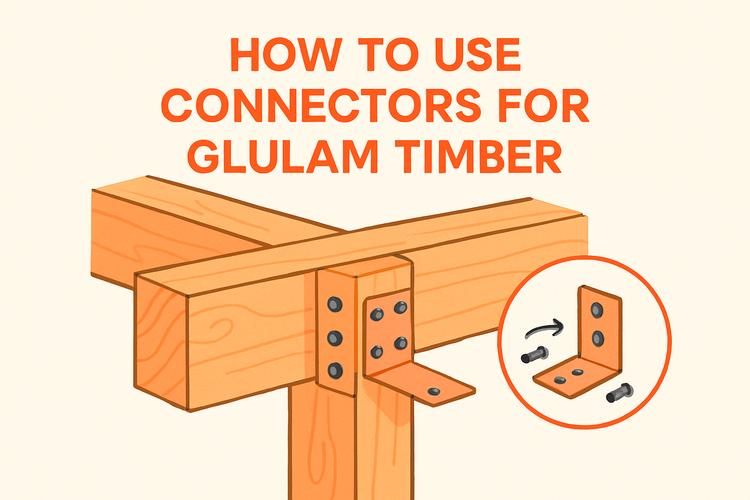How To Use Connectors For Glulam Timber In Construction

Understanding the Role of Connectors for Glulam Timber
Glulam timber is engineered to provide strength and stability, but effective construction depends heavily on the right connectors. These connectors are essential for transferring loads and maintaining the structural integrity of joints.
Connectors for Glulam Timber are specifically designed to work with laminated wood, allowing for more secure bonding between beams, columns, and other components. They accommodate the unique characteristics of Glulam, such as expansion and contraction, by providing needed flexibility and strength at connection points. The correct use not only ensures durability but also compliance with safety standards in modern construction.
Types of Connectors Suitable for Glulam Assemblies
A wide variety of connectors are available to suit different applications in Glulam construction. Choosing the correct type is essential for optimizing performance and meeting structural requirements.
Common connector types include beam hangers, concealed hangers, and angle brackets. Beam hangers are often deployed where beams meet exterior walls or other beams, offering clean load transfer. Concealed hangers provide a hidden profile for aesthetic projects that value finished interiors without drywall. Angle brackets, available in varied sizes and gauges, offer corner reinforcement and are often used in tensioned joints. For vertical support, Post Base connectors are especially designed to anchor Glulam columns to foundations effectively.
Angle Brackets are also widely used in Glulam construction, especially in trusses and frames where additional lateral support is required. High-duty brackets made from galvanised steel can resist moisture and corrosion, contributing significantly to the longevity of the structure. Also, when high wind resistance is required, these brackets are typically complemented by specialized hardware from High Wind Ties & Timber Connectors to strengthen the overall stability of the building.
Installation Techniques for Glulam Connectors
Correct installation is vital for maximizing the strength and safety of any Glulam timber connection. Mistakes in this phase can compromise the structural design and lead to premature wear or failure.
Installation usually begins with accurate placement of the Glulam elements such as beams or columns, ensuring each aligns with the intended load path. Marking pilot holes precisely is necessary to prevent cracking and misalignment. Installers use pre-drilled holes for mechanical fasteners like bolts or screws, often chosen based on calculated load conditions. It is vital to follow manufacturer guidelines for torque and spacing. For example, high-performance screws and nails are applied to minimize movement and ensure optimal tension.
In exposed applications, waterproof sealants may be used with connectors to prevent moisture ingress and timber decay. Additionally, it is critical to use galvanised or stainless-steel fasteners in conjunction with connectors, especially for external use. Ensuring flush fitting between contact surfaces helps achieve even bearing pressure, reducing the risk of stress concentrations. During complex assemblies, restraint can be achieved through the deployment of Restraint Straps to retain alignment until all connectors are secure.
Load Distribution and Structural Performance
One of the core purposes of using connectors in Glulam timber structures is to distribute loads efficiently across joints and supporting structures. Ignoring load calculations can lead to overstressed elements and long-term failures.
Each connector type functions to support specific load directions—vertical, shear, or lateral. For example, concealed beam hangers mostly carry vertical loads but can be reinforced with brackets or straps to handle uplift forces. Bolted connections and angle brackets allow for controlled distribution across wide bearing areas, reducing stress on any single point. Proper engineering ensures that structural members and their connectors work together to enable even load paths throughout the construction.
In multi-storey frameworks or long-span roofing systems, Glulam often works alongside Roof Connectors to reduce deflection and sway. These connectors supplement load resistance in both static and dynamic conditions. Standard testing methods, including moment resistance analysis and pull-out testing, are applied during design and after installation. This ensures that the structure not only performs under dead loads but also endures live loads such as wind or occupancy movement.
Durability & Environmental Considerations
The performance and longevity of Glulam connectors are closely tied to material resistance and environmental conditions. When used outdoors or in high-moisture zones, choosing corrosion-resistant hardware is crucial.
Stainless steel and hot-dip galvanized finishes offer added protection against weather-induced degradation. Even connectors installed indoors must account for humidity cycles, as timber naturally expands and contracts. Long-term movement can loosen poorly chosen fasteners, introducing gaps or weak points in the structure. Products designed specifically for Glulam bonding endure these stresses better than generic hardware.
For projects that prioritize sustainability, responsibly sourced connectors with high recyclability ratings are increasingly available. Glulam itself is a sustainable alternative to solid timber, and using environmentally certified hardware complements eco-friendly architectural goals. Some installations may combine these with modular components from the related category of Connectors for Cross Laminated Timber when integrating hybrid wood systems. As building codes evolve, emphasis on durability and environmental performance continues to rise, driving the innovation of Glulam-compatible connectors even further.
